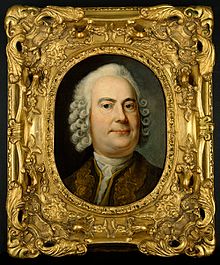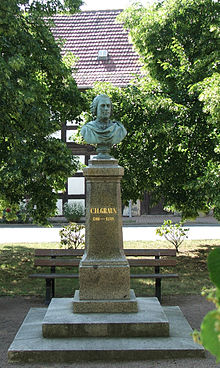Carl Heinrich Graun

Carl Heinrich Graun (* 1704 in Wahrenbrück ; † August 8, 1759 in Berlin ) was a German composer and singer .
Life

Graun followed his brother Johann Gottlieb Graun to the Kreuzschule in Dresden in 1714 , where he soon attracted attention with his beautiful voice. The Kreuzkantor Johann Zacharias Grundig and the organist of the Kreuzkirche, Emanuel Benisch , took over his vocal training; the organist and composer Christian Petzold taught him the keyboard instruments; the Saxon court conductor Johann Christoph Schmidt in composition and probably on the string instruments. In 1724, Graun was appointed court singer (tenor) to Braunschweig, where he composed operas alongside the local court conductor Georg Caspar Schürmann and was promoted to vice conductor at the opera house on Hagenmarkt . Graun wrote the opera Lo Specchio della Fedelta for the wedding celebrations of the Prussian crown prince Friedrich and the bevian princess Elisabeth Christine , which had its world premiere in 1733 in Salzdahlum . The Crown Prince was so enthusiastic about the opera that he expressed the wish that Duke Ludwig Rudolf would allow him to sign the composer to his court in Rheinsberg . In fact, in 1735, he and his brother - the concertmaster and composer Johann Gottlieb Graun - entered the chapel of the Prussian Crown Prince and later King Frederick the Great as Vice Kapellmeister. Here he had to compose and perform concert cantatas, the number of which is estimated at 50.
In 1740, after Friedrich's accession to the throne, Graun was appointed Kapellmeister and sent to Italy to recruit singers for the Italian Opera to be built in Berlin. The newly built Royal Court Opera Unter den Linden opened on December 7, 1742 with his opera Cesare e Cleopatra . After returning to Berlin and his office, he turned completely to opera and was so appealing to the king and the public that he was soon a star of Berlin opera and was able to assert himself as such until his death. In addition to the works of Johann Adolph Hasse, his operas formed the mainstay of the Berlin opera program.
Around the middle of the 18th century, Graun developed a fully chromatised syllable system, denominating fixed pitches , which was to replace solmisation .
Graun was married twice and had a daughter with his first wife, who also became a singer, and four sons from their second marriage. In his autobiography Speak, Memory, the Russian-American writer Vladimir Nabokov describes himself as the great-grandson of one of the composer's great-grandsons.
His grave was at the Petrikirche in Berlin Alt-Cölln on Mühlendamm, which was destroyed in the last days of the war in 1945 , the remains of which were completely demolished in 1964. In the Berlin district of Gesundbrunnen is gray street named after him.
plant
Graun shares with the Dresden conductor Johann Adolf Hasse (1699–1783) the merit of leading the Italian opera by Alessandro Scarlatti to its climax, which somewhat obscured the public's view of the works of other contemporaries such as Handel .
With Gluck's appearance , his operas disappeared from the repertoire forever, while his passion music “ The Death of Jesus ”, first performed in 1755 , has long been part of the concert programs at various locations, especially at the Sing-Akademie zu Berlin . The Singakademie performed the work as Good Friday music for decades until it was replaced by these after the rediscovery of Bach's Passions.
In addition to passion music and 28 operas, Graun left behind some instrumental compositions as well as many church music works, including a Te Deum .
Stage works
- Polidorus (5 acts, 1726 or 1731)
- Sinilde, conquering in her innocence (3 acts, 1727)
- Iphigenia in Aulis (3 acts, 1728)
- Scipio Africanus (3 acts, 1732)
- Lo specchio della fedeltà (3 acts, 1733)
- Pharaoh Tubaetes (5 acts, 1735)
- Rodelinda, regina de'Langobardi (3 acts, 1741)
- Cleopatra e Cesare (3 acts, 1742)
- Artaserse (3 acts, 1743)
- Catone in Utica (3 acts, 1743)
- Alessandro e Poro (3 acts, 1744)
- Lucio Papirio (3 acts, 1744)
- Adriano in Siria (3 acts, 1746)
- Demofoonte (3 acts, 1746)
- Cajo Fabricio (3 acts, 1746)
- Le festa galanti (festa teatrale, 1747)
- Cinna (3 acts, 1748)
- L'Europa galante (festa teatrale, 5 acts, 1748)
- Ifigenia in Aulide (3 acts, 1748)
- Angelica e Medoro (3 acts, 1749)
- Coriolano (tragedia per musica, 3 acts, 1749)
- Fetonte (tragedia per musica, 3 acts, 1750)
- Il Mithridate (tragedia per musica, 3 acts, 1751)
- Armida (3 acts, 1751)
- Britannico (tragedia per musica, 3 acts, 1751)
- L'Orfeo (tragedia per musica, 3 acts, 1752)
- Il giudizio di Paride (pastorale per musica, 1 act, 1752)
- Silla (3 acts, 1753)
- Semiramide (3 acts, 1754)
- Montezuma (tragedia per musica, 3 acts, 1755) Libretto by Friedrich II.
- Ezio (1755)
- I fratelli nemici (tragedia per musica, 3 acts, 1756)
- Merope (tragedia per musica, 3 acts, 1756)
Other works (selection)
- Great Passion Come and see
- Te Deum
- The Death of Jesus (Passion Oratorio, 1755)
- Oratorio in Festum Nativitatis Christi
- Easter Oratorio
- Six Italian cantatas
- Songs (in Friedrich Graefe's collection of various and selected odes, 1743)
- Concerto for horn, strings and harpsichord in D major
- Sinfonia in C major
Catalog raisonnés
- John W. Grubbs: The sacred Choral Music of the Graun Brothers. (1972)
- Carl Mennicke: Hasse and the Graun brothers as symphonic orchestras. (1906) (Hasse: 86, Carl Heinrich: 32, Johann Gottlieb: 115, incl. 14 incorrect assignments)
- Matthias Wendt: The Graun brothers' trios. (1983) (143, incl. 4 incorrect assignments)
- Monika Willer: The Graun brothers' concert form. (1995) (161, incl. 7 misallocations)
- Christoph Henzel: Graun catalog raisonné (GraunWV). Ortus Musikverlag (2006) ISBN 978-3-937788-02-9 , 2 volumes
Afterlife
In the Bad Liebenwerda district museum , a permanent exhibition provides information about the life and work of the Graun brothers . Also in Bad Liebenwerda there has been an international competition for the Gebrüder Graun Prize every two years since 2003 , and since 2011 it has been linked to a music festival. The music school of the Elbe-Elster district has been called "Gebrüder Graun" district music school since 1994 .
literature
- Graun . In: Meyers Konversations-Lexikon . 4th edition. Volume 7, Verlag des Bibliographisches Institut, Leipzig / Vienna 1885–1892, p. 639.
- Georg Feder: Graun, Carl Heinrich. In: New German Biography (NDB). Volume 7, Duncker & Humblot, Berlin 1966, ISBN 3-428-00188-5 , p. 10 f. ( Digitized version ).
- Moritz Fürstenau : Graun, Carl Heinrich . In: Allgemeine Deutsche Biographie (ADB). Volume 9, Duncker & Humblot, Leipzig 1879, pp. 607-609.
Web links
- Works by and about Carl Heinrich Graun in the catalog of the German National Library
- Works by and about Carl Heinrich Graun in the German Digital Library
- Carl Heinrich Graun in the Bavarian Musicians' Lexicon Online (BMLO)
- Search for operas by Carl Heinrich Graun (search term in the Autore field : "Graun Carl Heinrich") in the Corago information system of the University of Bologna
- Sheet music and audio files by Carl Heinrich Graun in the International Music Score Library Project
- Sheet music in the public domain by Karl Heinrich Graun in the Choral Public Domain Library - ChoralWiki (English)
- Score of the opera “Montezuma” (edited by Albert Mayer-Reinach in the series Monuments of German Tonkunst , Leipzig 1904), accessed on July 15, 2014
Individual evidence
- ↑ GND 118541706 life data: 1704–1759 (year of birth approx., Also 1701 or 1703; imprecise data due to loss of the Wahrenbrück church book due to fire)
- ^ Stanley Sadie (ed.): The New Grove Dictionary of Music and Musicians. Macmillan, London 1989, entry "Carl Heinrich Graun".
- ↑ Exhibition catalog From the ducal court theater to the bourgeois touring theater . H.-H. Grote (1992) Wolfenbüttel, pp. 45, 46.
- ↑ Vladimir Nabokov: Speak, Memory. An Autobiography Revisited . Vintage International, New York 1989, p. 54.
- ↑ Article ( Memento of December 8, 2012 in the Internet Archive ) on the website of the Dachverband Kulturfeste in Brandenburg e. V.
- ↑ Note on the website of the Elbe-Elster district, as of January 17, 2012.
| personal data | |
|---|---|
| SURNAME | Graun, Carl Heinrich |
| BRIEF DESCRIPTION | German composer and singer |
| DATE OF BIRTH | 1704 |
| PLACE OF BIRTH | Wahrenbrück |
| DATE OF DEATH | August 8, 1759 |
| Place of death | Berlin |



